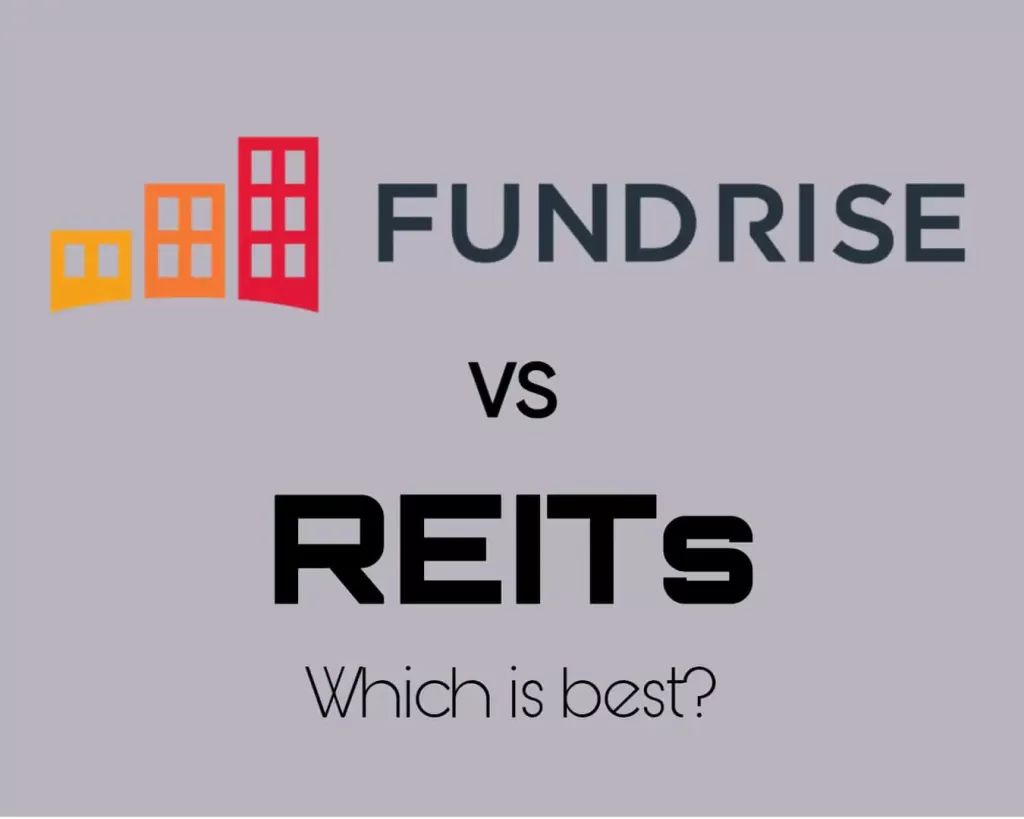When we step into the arena of real estate investing, a common dilemma we face is choosing between Fundrise vs. REITs. On one side stands Fundrise, an innovative platform offering private market real estate investing previously inaccessible to the average investor. On the other side are traditional real estate investment trusts (REITs) known for their liquidity and ease of entry. As we delve into comparing Fundrise and REITs, we consider various factors such as performance, fees, transparency, and liquidity to ascertain which is better Fundrise or a REIT for our investment portfolios.
Disclaimer: This information is general in nature and for informational purposes only. It is not personal financial advice and has not taken into account your personal financial position or objectives. Make sure to refer to a licensed financial or tax advisor.
Table of Contents
Key Takeaways
- Fundrise introduces the average investor to private real estate markets, changing the landscape previously dominated by high-net-worth individuals.
- REITs offer a public and liquid avenue to invest in diverse real estate sectors and geographies.
- Performance and fee structures differ between Fundrise, which promotes long-term growth, and REITs, which provide more immediate liquidity.
- When evaluating which platform to choose, individual investment goals and preferences on accessibility, potential returns, and trading flexibility come into play.
- Understanding the distinct characteristics of Fundrise’s eREITs and traditional REITs is critical for making an informed decision that aligns with one’s investment strategy.
Understanding Fundrise and Its Approach to Real Estate Investment
As we explore the intricacies of private real estate investment, online platforms like Fundrise have emerged as frontrunners in reshaping the landscape. By leveraging technology, Fundrise has managed to democratize real estate investing, allowing individuals to gain private real estate exposure that was once unreachable to them. Our focus is to dig deep into Fundrise’s unique features and understand how it stacks up in a Fundrise performance comparison with traditional methods of investing in real estate.
What is Fundrise and How Does it Democratize Real Estate Investing?
We’ve witnessed how Fundrise operates as an innovative space where average investors can tap into the world of private real estate. But what does it mean to democratize real estate investing? It creates a platform where barriers are lowered, and opportunities are made widely available, offering a form of investment once accessible only to the affluent or institutional backings. With Fundrise, it’s more than possible—it’s happening every day, with over 390,000 investors and counting.
Exploring the Fundrise Platform’s Unique Features and Offerings
Fundrise isn’t just another investment platform; it’s an ecosystem rich with diverse real estate exposure. From tax-advantaged retirement accounts to personalized portfolios, the range of options ensures investors can find their niche. The platform blends accessibility and savvy financial strategies, allowing investors to cleverly navigate the realm of private real estate investment with ease and confidence.
Fundrise’s eREITs vs. Traditional REITs: A Contrast in Accessibility and Structure
The comparison of Fundrise’s eREITs and traditional REITs uncovers a landscape where Fundrise innovates with its structure and accessibility. EREITs, or electronic real estate investment trusts, propose an alternative route to the usual public real estate avenues. The allure of these eREITs lies in their quarterly dividends and approach to real estate, diverging from the path traditional REITs typically walk. So, when evaluating eREITs vs traditional REITs, it’s important to recognize the nuanced differences in terms of market exposure and accessibility.
Real Estate Investment Trusts (REITs) Explained
When we consider broadening our investment horizon, public real estate investment trusts, commonly known as REITs, present themselves as a formidable bridge between the real estate market and stock market. The benefits of investing in a REIT are manifold and cater to the needs of investors aiming for income, growth, and diversification in their portfolios.
At their core, REITs allow us to channel our funds into vast arrays of real estate assets including but not limited to sectors like industrial, residential, and office spaces, along with niches such as healthcare facilities. Unlike investing in physical properties, which requires a significant amount of capital, management know-how, and high involvement, REITs abstract these complexities through professional management teams.
With REITs being traded entities on major stock exchanges, they offer the dual advantages of transparency and liquidity. This means we can partake in the economic benefits of real estate without having to deal with the intricacies of direct property ownership. The liquidity of REITs is an appealing feature that cannot be overstated; it allows us to buy or sell shares on demand during the trading hours of the exchange, a flexibility not always afforded by direct investments in physical properties.
- Competitive Returns – An incentive through the potential for both capital appreciation and ongoing dividends.
- Steady Dividends – Since REITs are mandated by law to distribute at least 90% of their taxable income as dividends, they serve as robust income-generating investments.
- Diversification – By investing across a variety of property sectors and geographical areas, REITs mitigate risk through diversification.
For those of us who are new to REITs or are considering incorporating them into our investment portfolio, the entrance is made accessible through low-fee mutual funds and ETFs that specialize in public real estate investment trusts. This layered strategy amplifies the appeal, forging a path to real estate market involvement while availing the benefits of cost-effective fund management and broader exposure.
The keen balance struck by REITs between accessibility, yield, and diversification, encapsulates their value proposition in the investment landscape. As we navigate the complexities of building a robust and resilient investment portfolio, REITs continue to shine as a lighthouse, guiding us toward the shores of capital growth, income, and stability.
Investment Performance: Evaluating Fundrise and REITs
At the core of any astute investment strategy is the performance analysis of chosen vehicles. In the sphere of real estate, the strength of Fundrise’s investment performance is often juxtaposed with traditional REITs to provide investors with insights for portfolio optimization. Embracing a comprehensive real estate portfolio management approach, our focus on passive income through dividends, portfolio growth through appreciation, and consistent cash flow assets forms the backbone of our investment philosophy. In this context, our strategies not only target immediate returns but also emphasize long-term appreciation and stability. By analyzing data and trends in the real estate market, we aim to optimize returns while minimizing risk for our investors. Moreover, the concept of monthly dividend stocks explained is crucial for understanding how consistent income generation can enhance overall portfolio performance and provide financial security in an unpredictable market.
Fundrise Performance Comparison with Traditional Investment Vehicles
When it comes to alternatives for generating substantial returns, investors commonly weigh the merits of Fundrise against other investment vehicles. A distinguishing factor is our dedication to collage a myriad of real estate projects, which invariably aims to balance the portfolio and expand the prospects for passive income through dividends. This aspect particularly resonates with individuals eyeing relatively hassle-free revenue streams while engaged in other personal or professional pursuits.
Historical Returns of Fundrise and Their Impact on Investor Portfolios
Assessing historical returns of Fundrise offers a tangible benchmark for potential growth. We align our strategies closely with market dynamics, fostering portfolio growth through appreciation and dividends that have historically produced a competitive edge for our client’s portfolios. Scrutinizing past performance, especially during challenging economic climates, continues to reassure our clients of the robustness and resilience inherent in our investment constructs.
| Year | Fundrise Annual Returns | REIT Index Annual Returns |
|---|---|---|
| 2019 | 9.47% | 24.7% |
| 2020 | 7.42% | -2.0% |
| 2021 | 22.99% | 40.1% |
As demonstrated, the historical returns of Fundrise showcase a trajectory validating our commitment to value creation and longevity. Our proactive real estate portfolio management, centered on capitalizing on consistent cash flow assets, amplifies our clients’ investment narratives, ultimately proffering the reverence they seek towards achieving their financial aspirations.
Liquidity Concerns: Redemption Policies of Fundrise and REITs
When it comes to liquidity in real estate investment, understanding the nuances between different investment vehicles like Fundrise and traditional REITs is crucial. One of the primary considerations is how these entities handle redemptions, which essentially boils down to how easily you, as an investor, can convert your investment back to cash.
Fundrise’s redemption policies are designed with a quarterly redemption schedule, which means that liquidity is not immediate. If you need to access your funds, it’s important to plan ahead, as redemption requests are only processed at specific times throughout the year. This mechanism ensures the stability of Fundrise’s investments but can pose a challenge if you require quick access to your funds.
Take for instance Fundrise’s Flagship Fund or the Income Fund—while they offer a more lenient redemption option, those funds not falling under these categories impose a typical 1% early withdrawal fee. However, during times when there’s a high volume of redemption requests, Fundrise may place limitations to maintain the fund’s overall health. It’s a safeguard measure that favors the collective over individual liquidity needs.
Contrarily, traditional REITs provide significantly more liquid options. Their shares are traded on stock exchanges, allowing investors to buy and sell during market hours, which can be ideal for those who value or might require the flexibility to liquidate rapidly.
- – Fundrise requires planning for redemptions with its quarterly schedule
- – Traditional REITs offer more frequent trading opportunities
- – Fundrise may impose limits in high redemption periods to protect stability
- – Traditional REITs are more akin to stock trading in terms of liquidity
In sum, we recommend that investors weigh their need for liquidity against their investment goals when choosing between Fundrise and traditional REITs. Liquidity in real estate investment is a critical factor that varies substantially between these options; hence, knowing the specifics of Fundrise’s redemption policies and the quarterly redemption schedule is key to making an informed decision that aligns with your financial strategy.
Is Fundrise Better Than a REIT?
When we weigh the merits of Fundrise vs traditional REITs, we consider the spectrum of factors influencing an investor’s decision. It’s a multidimensional comparison, where the unique characteristics of each real estate investment option come under scrutiny, including fees, transparency, and liquidity — the pillars affecting the success and suitability of an investment.
Comparing Fundrise and REITs on Fees, Transparency, and Liquidity
With Fundrise, investors face a straight-forward fee structure, which could be seen as a cost-effective investment option, especially if we account for the absence of certain brokerage commissions commonly associated with traditional REITs. On the transparency front, REITs typically lead the pack because they are subject to stringent reporting due to their stock exchange listings. However, Fundrise counters with comprehensive updates about investment properties, facilitating real estate investment democratization. Liquidity is where REITs have an edge, offering real-time real estate trading during market hours, a significant benefit for those who value flexibility and quick access to funds.
Advantages of Investing in Fundrise over Traditional REITs
The advantages of investing in Fundrise are noteworthy. Fundrise champions the democratization of real estate investment assets, bringing what used to be a playground for the wealthy straight to our fingertips. The platform provides tailored investment strategies and individualized portfolio management, which attract investors seeking a more hands-on approach to their investments. Moreover, the potential for higher returns and specific offerings such as Fundrise Pro presents strong arguments for those looking to diversify beyond public markets.
Benefits of Investing in a REIT Over Fundrise
In contrast, traditional REITs benefits include their potential for lower overall fees, given that there are no dedicated advisory fees and they are devoid of early withdrawal penalties, making them attractive for a variety of investors. Their hallmark is professional real estate management across diverse real estate asset classes and markets, offering an expansive reach that Fundrise typically does not. Additionally, the assured liquidity and familiarity of publicly-traded REITs strike a chord with those of us who prefer to treat real estate investments with the same agility as stock market trades.
FAQ
Q: What is the difference between Fundrise and REITs?
A: Fundrise is a real estate crowdfunding platform that allows individuals to invest in private real estate, while REITs (Real Estate Investment Trusts) are publicly traded companies that invest in various real estate properties.
Q: Which investment strategy is better – Fundrise or REITs?
A: The choice between Fundrise and REITs depends on individual preferences and investment goals. Fundrise offers a more direct investment approach in individual real estate properties, while REITs provide the advantage of liquidity and diversification through publicly traded shares of real estate interests.
Q: What is the minimum investment required for Fundrise and REITs?
A: Fundrise typically requires a lower minimum investment compared to traditional REITs. The minimum investment for Fundrise can vary but is generally more accessible to individual investors.
Q: Are Fundrise eREITs similar to basic REITs?
A: Fundrise eREITs are similar to traditional REITs in that they both provide investors with the opportunity to invest in real estate. However, eREITs are offered through Fundrise’s platform and focus on commercial real estate, while traditional REITs are publicly traded on the stock market and invest in a variety of real estate properties.
Q: Can I invest in REITs through an ETF like Vanguard Real Estate ETF?
A: Yes, investors can choose to invest in publicly traded REITs through exchange-traded funds (ETFs) such as the Vanguard Real Estate ETF, providing exposure to a diversified portfolio of listed REITs.
Q: What are the benefits of investing in Fundrise over REITs?
A: Investing in Fundrise offers the potential for adding low-cost real estate investments to a portfolio without the requirements of high initial investments or the fluctuations associated with publicly traded REITs.
Q: Are private REITs better than publicly traded REITs?
A: The preference between private and public REITs depends on individual investment objectives. Private REITs may offer less liquidity but could provide opportunities for investing in specific real estate projects with longer investment horizons.
Q: Can I invest in real estate crowdfunding through traditional REIT platforms?
A: Real estate crowdfunding, as offered by Fundrise, typically involves direct investment in individual real estate properties, which differs from the structure of traditional REIT platforms that focus on publicly traded real estate shares.
Q: How can I determine whether Fundrise or REITs are best for my real estate investment goals?
A: Assessing investment goals, risk tolerance, minimum investment requirements, liquidity needs, and the specific properties or projects of interest can help in determining whether Fundrise or REITs are better suited for individual real estate investment strategies.
Q: Are there options to invest in low-cost real estate without the volatility of REITs?
A: Yes, platforms like Fundrise offer opportunities to invest in low-cost real estate without the fluctuation associated with publicly traded REITs, providing a more stable and direct approach to real estate investment.







